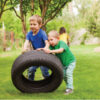
by Tara Highway
Swimming Squidz
As summer arrives offering the chance for long lazy days on the beach or at the lido and with the possibility of paddling pools or swimming pools in the garden, not forgetting the flurry of ‘summer’s here’ excitement everywhere, we need to be sure we are not ‘throwing safety to the wind’.
Water safety needs to be at the forefront of our minds at all times, but especially over the summer months.
A recent survey carried out by the Drowning Prevention Charity, Royal Life Saving Society (RLSS) www.rlss.org.uk, showed that 1 in 10 people had almost drowned at some point in their lives and that 13% of people knew someone who had drowned.
During the period of May through to August, the number of drownings increase hugely, and between the UK and Ireland, there are on average 402 drownings a year. Children and young people aged under 19 accounted for 57 deaths – 19 were under 10 years old. Worldwide the (conservative) figure of deaths by drowning is estimated to be 235,000 every year!
The importance of water safety cannot be expressed strongly enough. It is one of the most imperative things for a child to learn and they should be taught as early as possible. They need to be aware of how to help themselves, be aware of the dangers around them and what they can do to help someone else in an emergency.
So, what can we do to help our children in and around water?
Swimming lessons from as early as possible is a great start. An early introduction to the water can teach them how to help themselves – from blowing bubbles and breathing to rolling onto their back so that they can breathe. We need to help them recognise dangers and how to stay safe by being able to climb in and out of the water safely on both a solid or potentially wobbly surface. We can teach them how to rescue another person by using equipment around them and checking for dangers nearby, and how to stay low themselves to pull someone out of water ensuring they are well grounded and less likely to be pulled in too!
Understanding survival techniques and knowing how to put them into practice is also an invaluable skill. For example, how to be able to control the situation if they were to fall into an icy lake and how to guide themselves out. This understanding is invaluable and could one day be the difference between life and death.
We also all need to know about the dangers of ‘Cold Water Shock’. CWS causes the blood vessels in the skin to close, creating a resistance in blood flow, causing the heart to work harder. Blood pressure increases and the potential for a heart attack increases too – even in the young and healthy. It is not that commonly known about although with the increase in open water swimming since the pandemic, it has become far more highlighted. These are just a few things we need to teach our children about how to be safe in and around water.
On your family fun days around the pool or at the beach there are simple things you can put in place and believe it or not, these can be as simple as the colour of your swimming costumes! For example, both blue and white swimming costumes become all but ‘invisible’ in the water, so if you are in trouble it is far more difficult for your rescuer to see you and help you. If you are in a brightly coloured swimming kit (neon orange and pink for example) you are instantly more noticeable. MAKE YOURSELF VISIBLE.
When setting up at the beach ensure you have plenty of shade and plenty of drinking water and try to be in sight of the lifeguards.
Observe any lifeguard flags that have been put in place and know what they mean.
Red = NO swimming, red and yellow = lifeguard on duty, swim between the flags, yellow = seek advice, green = safe to swim, black and white = surfing area, NO swimming and white and blue = diving in progress.
Be aware of the tides and learn about rip tides in the area. Rip tides are long narrow bands of water that flow quickly away from the shore and are extremely dangerous. The sea might seem a calm but rip tides, which form in waves, quickly pull a swimmer away from the shore.
Ask the lifeguards for waterproof wristbands which you can write your contact details on and place on the wrist of each of your children so that, if you become separated at the beach, you can be contacted.
Remember, at the beach we can call 999 for lifeboat and the Coastguard.
Throughout my teaching career, I’m aware of at least two situations where children who I teach have been out with their parents and they had known exactly what to do in a hazardous situation. Firstly, a little three year old boy went fishing with his father in October and he fell, fully clothed, into the river. He knew straight away to roll onto his back and float – he hated back floating in class and often refused to do it – but when it counted he knew what to do until his father got him to safety. Secondly, whilst on holiday a six year old girl saw her younger brother slip on the step of the pool and fall under the water but she managed to get him out safely without causing any danger to herself!
Keep yourself and your little ones safe and aware of all the dangers in and around the water – a little preparation can make a big difference. Hoping you have a fun summer and enjoy the water safely.
Swimming Squidz, is a family run business teaching babies and children up to the age of 11 to love the water while staying safe.
www.swimmingsquidz.co.uk











